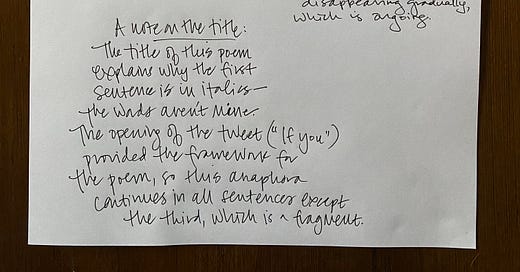I’m happy to see so many of you joining me as I launch this project. Welcome!
One of the things I’m excited to do in this newsletter is share behind-the-scenes looks at poems and essays.
I don’t know about you, but when I read a poem or hear a song or see a piece of visual art that resonates with me, I want to know how it happened. What was the spark or inspiration behind the piece? Why did they make those specific craft choices? What challenges did they face? How did they surprise themselves along the way?
Most of the time, we can only guess at the answers to these questions, because we don’t have access to the artist. Most of the time, we aren’t invited to peek behind the curtain. So let’s change that here. Come on inside.
First up is “Poem Beginning with a Retweet,” from my last collection, Goldenrod.* Yes, I realize I have idiosyncratic handwriting, so I hope my annotations are clear enough. I write all of my poems longhand first, either in a notebook or on a yellow legal pad, so handwriting is an important part of my writing life. I wanted to keep that personal touch here with the annotations, too. (And occasionally I’ll share early handwritten drafts of poems or essays. It’s always wild to see the initial, inarticulate scribblings and compare those to the published versions.)
Here I’ve made notes about the original inspiration for the poem, the logic behind the title, and some of the craft decisions I made related to sound, line breaks, repetition, and word choice. Some of these decisions made the initial draft possible; others came about during revision.
On line breaks specifically: I marked, with arrows, some turns at line endings that I chose for the sake of tension and suspense. I think of these line endings as suspenseful because the full meaning of the sentence is not yet available to the reader; the reader has questions that they must read on to have answered. For example, the line that ends “If you find an unbroken” prompts the reader to ask, “An unbroken what?” Reading on provides the answer: a sand dollar.
Keep an eye on your inbox this week for a craft tip related to this poem. And paid subscribers should keep an eye out for a writing prompt and revision hack, too. To make this space teacher-friendly, I’ll do my best to link up annotations, craft tips, and other writing and teaching resources. I’m going to be mindful about these connections.
Some of these goodies, like writing prompts, revision hacks, lesson ideas, and deeper craft discussions, will be sent to paid subscribers only, so if you’d like to upgrade to paid, you can do so at any time. Being a paid Dear Lifer means you’re making it possible for me to write. It’s that simple, and that enormous. Thank you.
Either way, I’m so glad you’re here.
Love and gratitude,
Maggie
* Before “Poem Beginning with a Retweet” appeared in book form in 2021, it appeared in the Summer 2019 issue of Colorado Review. A quick search of my email tells me I submitted the poem to Felicia Zamora in early 2017. I note the years here because the editors of literary magazines often give poems their first homes well before they have a book to live inside. I imagine that being in a book probably makes a poem braver and more sure of itself, the way having a stable, loving home makes us feel. Before poems have a book-home, they’re just wandering, knocking on doors, hoping someone will welcome them inside and give them shelter and a sense of belonging. If you look at the acknowledgments page of a poetry collection, you’re looking at a list of editors who opened the door and took a chance on the work. Home-givers. Thank you, Felicia and CR.





I love reading and learning about the craft elements contained in this marvelous poem. Thank you for sharing ❤️
Really fun to read about the process behind your writing. Excited for more of this!